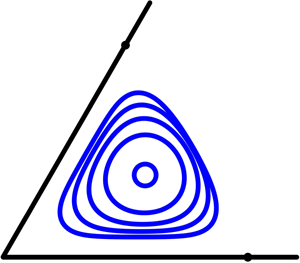Article contents
Hollow vortex in a corner
Published online by Cambridge University Press: 07 December 2020
Abstract

Equilibrium solutions for hollow vortices in straining flow in a corner are obtained by solving a free-boundary problem. Conformal maps from a canonical doubly connected annular domain to the physical plane combining the Schottky–Klein prime function with an appropriate algebraic map lead to a problem similar to Pocklington's propagating hollow dipole. The result is a two-parameter family of solutions depending on the corner angle and on the non-dimensional ratio of strain to circulation.
JFM classification
- Type
- JFM Rapids
- Information
- Copyright
- © The Author(s), 2020. Published by Cambridge University Press
References
REFERENCES
- 3
- Cited by



